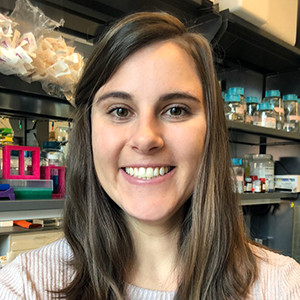Bacterial enzyme catalyzes body odor compound formation
Body odor is universal to most mammals — the microbes inhabiting our skin turn odorless gland secretions into volatile chemicals with distinct scents. A skin-resident bacteria, Staphylococcus hominis, transforms sweat gland metabolites into sulfur-containing compounds associated with body odors like those from onions via a two-step process.
In a recent Journal of Biological Chemistry paper, researchers identified an S. hominis enzyme, called ShPepV, that catalyzes the first step in this chemical transformation. Reyme Herman, a graduate student in Gavin Thomas’ lab in the department of biology at the University of York, is the first author on the paper.

Herman and colleagues from the University of York and Unilever previously reported on the second enzymatic step in the reaction, but the first eluded them.
Herman and colleagues initially tried to identify enzyme gene candidates computationally, but didn’t find a clear target. The group then screened portions of S. hominis cellular extracts using an assay to detect the end-product of the reaction as a means to monitor enzymatic activity to try to identify the protein. Proteins from extracts that demonstrated enzymatic activity were separated on a gel and identified using peptide mass fingerprinting.
The research team found that the dipeptidase enzyme ShPepV was responsible. Herman said the discovery of this enzyme was surprising because ShPepV belongs to a class of enzymes not previously associated with this process.
The team monitored the enzyme kinetics of purified ShPepV to better understand its biochemistry. By removing and adding specific metals, researchers identified manganese as a metal cofactor. Protein structure was investigated using modeling to similar proteins. Based on these models of the protein binding site, the team investigated the residues and structural features key to enzymatic activity with purified recombinant protein. They found that the enzyme demonstrated broad activity and had binding site properties—such as a large hydrophobic cavity — similar to other dipeptidase enzymes.
“The molecule that the bacteria processes to make (body odor) have a unique shape and requires special accommodation by bacterial proteins,” Herman said. “We identified a similar structure feature in PepV that allows for the accommodation of this molecule.”
Herman said the team plans to continue their work to uncover the roles other bacterial species and their enzymatic processes have in contributing to body odor.
Currently, the team is testing how other skin-associated species contribute to body odor. Like with S. hominis, Herman said the group hopes to eventually understand the molecular processes underpinning the roles of these other bacterial species in odor formation.
“This ancient process is intertwined with our behaviors, affecting our interactions with each other,” Herman said. “(Our work will) contribute to our understanding of (body odor) formation, identifying enzymes that could be targeted for interventions of this process.”
The research furthers the understanding of the interplay between bacterial enzymes and the production of body odor in humans.
Enjoy reading ASBMB Today?
Become a member to receive the print edition four times a year and the digital edition monthly.
Learn moreGet the latest from ASBMB Today
Enter your email address, and we’ll send you a weekly email with recent articles, interviews and more.
Latest in Science
Science highlights or most popular articles

Mapping fentanyl’s cellular footprint
Using a new imaging method, researchers at State University of New York at Buffalo traced fentanyl’s effects inside brain immune cells, revealing how the drug alters lipid droplets, pointing to new paths for addiction diagnostics.

Designing life’s building blocks with AI
Tanja Kortemme, a professor at the University of California, San Francisco, will discuss her research using computational biology to engineer proteins at the 2026 ASBMB Annual Meeting.

Cholesterol as a novel biomarker for Fragile X syndrome
Researchers in Quebec identified lower levels of a brain cholesterol metabolite, 24-hydroxycholesterol, in patients with fragile X syndrome, a finding that could provide a simple blood-based biomarker for understanding and managing the condition.

How lipid metabolism shapes sperm development
Researchers at Hokkaido University identify the enzyme behind a key lipid in sperm development. The findings reveal how seminolipids shape sperm formation and may inform future diagnostics and treatments for male infertility.

Mass spec method captures proteins in native membranes
Yale scientists developed a mass spec protocol that keeps proteins in their native environment, detects intact protein complexes and tracks drug binding, offering a clearer view of membrane biology.

Laser-assisted cryoEM method preserves protein structure
University of Wisconsin–Madison researchers devised a method that prevents protein compaction during cryoEM prep, restoring natural structure for mass spec studies. The approach could expand high-resolution imaging to more complex protein systems.

